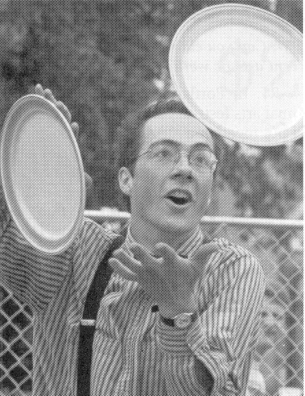
Rhys Thomas, master of "kitchenary juggling". (Sherry Wilmsen photo) |
Page 21 Fall 1994
|
Rhys's
juggling technique matches his verbal
virtuosity - he juggles and even multiplexes five clubs,
cascades seven balls, and performs an impressive array of unusual
five-ball site-swaps and multiplexes in his routine of "classical
ballet."
Although
not jugglers themselves, creativity runs in Rhys's family, and he
found strong support there for his creative impulses. His father is a
designer, sculptor, graphic artist, musician and fire chief. His
mother is a baker, soft
sculptor, tie-dye artist, musician and teacher. His sisters are visual
artists.
In
high school, Rhys recounts, "I learned to juggle to impress a
girl; later, I lost the girl and juggled to forget." Crow,
Oregon, Rhys's hometown, nestled in the rural Willamette Valley, is,
in Rhys's words, "a tiny town in the middle of nowhere." Not
especially interested in organized sports as a kid, and unable to
watch much TV because of the poor reception, Rhys took to juggling
naturally.
Performing opportunities arose, among other places, at the Oregon Country Fair, where his family has had a booth for years. The Oregon Country Fair, an annual threeday event in mid-July, evolved out of a sleepy renaissance fair over 20 years ago. Animated by a spirit of community and fantasy, the fair still retains its counter-culture / alternative spirit despite its dramatic growth. Rhys's early exposure at the fair to such performers as Avner the Eccentric, the Karamazovs (who would juggle torches naked on stage), and the Laughing Moon Theatre (who would bring an entire Italian meal out of a hat) sparked his interest in performing.
He
put together a show and began performing at the fair himself. Of
the jugglers he saw in his formative years, Roberto Morganti (who won
the 3ball competition at the 1978 IJA convention in Eugene, Oregon)
taught him the most. More inspirational, however, were stories of his
friend David Lichtenstein's juggling exploits in San Francisco and in
Europe. Rhys recalls, "I'd think to myself, 'I'm in high school
doing homework, and David's juggling on the streets of Paris... That's
the life!' When I'd see his show I'd think, 'This is great. This is
me.'''
So
in college, at the University of Oregon, he met up a couple of other
jugglers, Tim Miller and Ken Glenn, and they put together an act with
a lot of singing, vaudeville and juggling in a group called Out to
Lunch. "My favorite bit," Rhys recounts, "was sitting
on each other's shoulders, three high, juggling, singing threepart
harmony, and doing totem pole impressions. Very Northwest. Later we
broke up, and I became 'Up For Grabs.'"
Rhys
was bitten by the performance bug. After acquiring a journalism degree
and a secondary education teaching certificate at the University of
Oregon and doing a stint
Rhys's
bread and butter show is an allages, "acrobatic comedy juggling
tour-defarce." Typical venues include corporate events, school
programs, fairs and festivals in Oregon, Washington and Alaska. He
adapts his basic show for specific audiences. For instance, he juggles
inflated 50gallon garbage bags in a recycling show at schools. In a
show for the Oregon State Fire Board he performed a fire eating
routine. At the International Congress of Neurological Surgeons he
slipped in jokes about split-brain activity while spinning balls and
rings on different limbs and fingers. At the Pacific Science Center in
Seattle, he performs his "Science Circus" routine, which
uses juggling as a vehicle to teach basic physics. He makes balloon
animals out of condoms in his "safe juggling" routine at
comedy clubs.
Other
noteworthy shows include a live broadcast from AT&T Bell
Laboratories. Along with ex-Karamozov Tim Furst and mathematician
Ronald Graham, Rhys taught Nobel Laureate Arno Penzias the physics of
ball spinning and the mathematical principles of site-swaps before a
worldwide television audience. For the occasion of the Washington
State centennial, Rhys received an arts grant in 1989 to research and
present three genres of performance popular in 1889 (vaudeville,
medicine show, and wild west). More recently, Rhys won the "Most
Inspirational" award at the
JW:
How do you come up with new
material? RT:
I glean ideas and inspiration from
JW:
Do you also have a collection of circus / vaudeville videos? RT:
Yes, but I never watch them. Some of them I've never even seen
once. There are two reasons: the time involved, and, well, it's like
what I used to say in the journalism school, "I don't read any
newspapers; I'm afraid they'd influence my style!" (That never
went over very well with the teachers.) I'd rather see a still of a
trick and take that as my goal, but reinvent all that leads up to that
image.
JW:
This relates to growing up relatively isolated in Crow, Oregon, and
how that helped you develop an individual style. While many jugglers
were stealing from each other's shows, you were collecting juggling
ephemera at junk shops. What other kinds of historical juggling do you
do? RT:
The kitchenary stuff is all based on old photos. For instance, pulling
the table cloth from beneath spinning bowls. My malt cup routine uses
real malt cups because, although I had read about shaker cup routines,
the Goodwill only carried malt cups. And lately, there's what Neil
Stammer calls "monkey tricks"-spinning a ring around one
ankle, for example, while balancing a spinning ball on your finger,
while spinning a ring on that arm, and juggling two balls with the
other hand. It's no Brunn finish, but old photos of such combination
tricks inspire me greatly. Monkey tricks interest me, and I'd like to
get better at it, because when you do that sort of body isolation
you've got to think |

Rhys Thomas, master of "kitchenary juggling". (Sherry Wilmsen photo) |